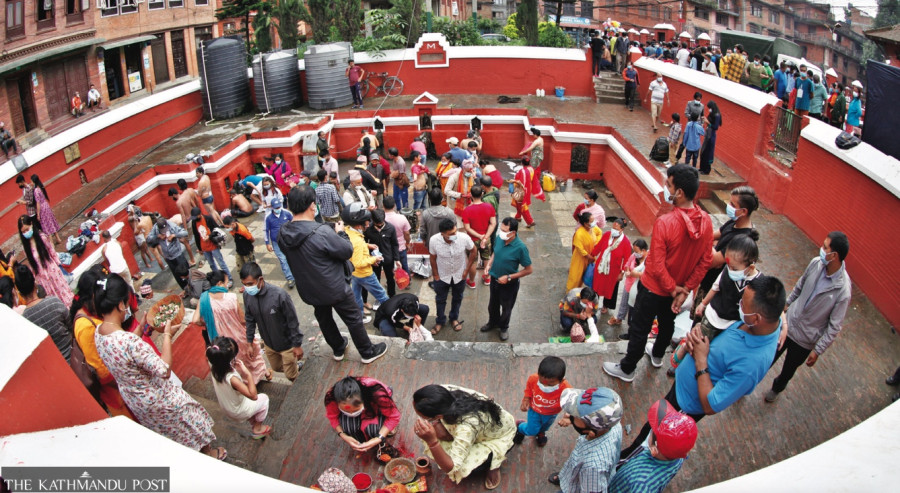Health
Festive season is here. Experts urge caution against virus
Doctors say wrong belief among people that vaccination makes them immune to infection and gatherings may drive infections up amid lax restrictions.
Anup Ojha
It’s 8am at Samakhusi on Janai Purnima, also known as Rakshya Bandhan, on Sunday. An awareness message about Covid-19 is repeating on a loudspeaker at the Metropolitan Police Circle saying ‘don’t come out of your homes, maintain a distance of at least two metres from people, wear a mask, don’t cause crowding....’
Signboards with similar messages line the walls of the help desk set up in front of the circle.
But a few meters away from the circle, on the roadside at Ranibari, four priests are tying Rakshya Bandhan, a sacred thread, on people’s wrists. There are around 50 people waiting for their turn.
Offering rituals at shrines, wearing Raksha Bandhan either from priests or sisters and changing the Janai, which is a thread worn across the torso by the tagadhari community, and feasting are major parts of the festival.
“I am fully vaccinated with two doses of the Covid-19 vaccine. The virus can’t do me any harm,” said Bishnu Hari Adhikari, 61, one of the priests as he tied sacred threads around his clients’ wrists. With his mask around the chin, he chanted mantras while tying the threads.
From early morning on Sunday, most of the Hindu shrines across the country including the Kathmandu Valley were crowded with people observing the Rakshya Bandhan rituals. In the Valley, Pashupatinath, Gorkarneshwar, Koteshwar Mahadev temple, Kuleshwar, Bagalamukhi and Mahalaxmisthan among others saw devotees in large numbers until noon while many people visited their relatives to celebrate the festival.
“We tried our best to convince people to avoid crowding but nobody seems to be listening. And we can’t shoot them or beat them up with batons,” said Durga Prasad Dahal, chief of the circle. He said his office had deployed police in the morning to curb crowding.
“We can’t detain them because they are so many and there is no place to detain all of them,” said Dahal.
The season of festivals has begun in Nepal. On Monday it is Gaijatra and several festivals are lined up for the next few months. Upcoming major festivals include Krishnajanmashtami, Teej, Indra Jatra and the biggest festivals of Dashain and Tihar, which fall in October and November.
Also on Saturday, the eve of the festival, markets in the capital were crowded with shoppers. Major groceries, sweet shops and clothing stores were packed with social distancing being ignored and many people were seen without masks and those who had masks weren’t wearing them properly.
After the Home Ministry issued a circular to the chief district officers across the country to control the mobility of people especially during festivals such as Janai Purnima and Gaijatra to contain the spread of Covid-19, the District Administration Office, Kathmandu on Friday published a notice asking people to maintain all the health protocols. But people were not giving two hoots to such notices.
Doctors say crowding during festivals provides a perfect platform for the coronavirus to spread and could lead the country into a third wave.
“If we look at last year, the Holi, Janai Purnima, Gaijatra and other big festivals like Dashain and Tihar had fueled the second wave. And the ongoing public behaviour shows that the country will soon be gripped by a third wave,” said Dr Sher Bahadur Pun, chief of the Clinical Research Unit at the Sukraraj Tropical and Infectious Disease Hospital.
Pun says that after a week, the country could see a surge of new infections. “As Gaijatra, Teej and the biggest festivals of Dashain and Tihar are on the way, they will surely increase Covid-19 cases,” said Pun.
“And if a new variant comes in then the situation might turn worse,” he added.
In the first week of August, Nepal’s Covid-19 death toll crossed the 10,000 mark. Last week, the Covid-19 Crisis Management Centre sent a circular to the chief district officers across the country to enforce smart lockdowns, although health experts found the idea puzzling. The government also introduced a ‘mask up’ campaign but the campaign seems to have little effect on the public.
Dr Basudev Pandey, former director at the Epidemiology and Disease Control Division says the festival season, people’s negligence to health protocol and poor enforcement of the restrictions may lead to a third wave.
Meanwhile, a study by the Ministry of Health and Population shows that over 50 percent of the country’s population has already been exposed to the SARS-CoV-2 that causes Covid-19.
“The antibody may protect some people but as the virus has been mutating into more infectious variants, I see the danger of a third wave. So both the government and the public should work hand in hand to fight the virus. The government should make necessary preparations and the public should follow the health protocols,” said Pandey.
The daily infection rate in the past few weeks has jumped to double compared to two months ago. On June 20, when the prohibitory orders were eased, Nepal recorded 1,421 new infections with 51 Covid-19 fatalities. In a span of two months, infections have doubled with the country reporting over 3,000 new cases until last week.
On Sunday, Nepal reported 1,702 new cases and 24 deaths. In the past 24 hours, Kathmandu Valley recorded 566 new infections — 395 cases were confirmed in Kathmandu, 110 in Lalitpur and 61 in Bhaktapur.
“These festivals have led to an increased physical contact among individuals and at the same time the health protocols are not being observed,” said Dr Pun. “The only way to protect ourselves is to learn from past mistakes.”




 9.12°C Kathmandu
9.12°C Kathmandu.jpg)













%20(1).jpg&w=300&height=200)
